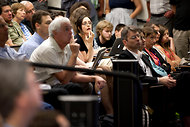ASPEN, Colo. — Signaling a likely end to one of the longest, most expensive searches in the history of science, physicists said Wednesday that they had discovered a new subatomic particle that looks for all the world like the Higgs boson, a key to understanding why there is diversity and life in the universe.
Physicists Find Elusive Particle Seen as Key to Universe

Scientists in Geneva on Wednesday applauded the discovery of a subatomic particle that looks like the Higgs boson.
By DENNIS OVERBYE
Published: July 4, 2012
Related
-
The Lede Blog: What in the World Is a Higgs Boson? (July 4, 2012)
Related in Opinion
-
Op-Ed Contributor: Why the Higgs Boson Matters (July 14, 2012)
Peter Wynn Thompson for The New York Times
Scientists at the Fermilab in Batavia, Ill., on Wednesday watched the presentation about the discovery of the Higgs boson, which was shown from Geneva.
Like Omar Sharif materializing out of the shimmering desert as a man on a camel in “Lawrence of Arabia,” the elusive boson has been coming slowly into view since last winter, as the first signals of its existence grew until they practically jumped off the chart.
“I think we have it,” said Rolf-Dieter Heuer, the director general of CERN, the multinational research center headquartered in Geneva. The agency is home to the Large Hadron Collider, the immense particle accelerator that produced the new data by colliding protons. The findings were announced by two separate teams. Dr. Heuer called the discovery “a historic milestone.”
He and others said that it was too soon to know for sure, however, whether the new particle is the one predicted by the Standard Model, the theory that has ruled physics for the last half-century. The particle is predicted to imbue elementary particles with mass. It may be an impostor as yet unknown to physics, perhaps the first of many particles yet to be discovered.
That possibility is particularly exciting to physicists, as it could point the way to new, deeper ideas, beyond the Standard Model, about the nature of reality.
For now, some physicists are simply calling it a “Higgslike” particle.
“It’s something that may, in the end, be one of the biggest observations of any new phenomena in our field in the last 30 or 40 years,” said Joe Incandela, a physicist of the University of California, Santa Barbara, and a spokesman for one of the two groups reporting new data on Wednesday.
Here at the Aspen Center for Physics, a retreat for scientists, bleary-eyed physicists drank Champagne in the wee hours as word arrived via Webcast from CERN. It was a scene duplicated in Melbourne, Australia, where physicists had gathered for a major conference, as well as in Los Angeles, Chicago, Princeton, New York, London and beyond — everywhere that members of a curious species have dedicated their lives and fortunes to the search for their origins in a dark universe.
In Geneva, 1,000 people stood in line all night to get into an auditorium at CERN, where some attendees noted a rock-concert ambience. Peter Higgs, the University of Edinburgh theorist for whom the boson is named, entered the meeting to a sustained ovation.
Confirmation of the Higgs boson or something very much like it would constitute a rendezvous with destiny for a generation of physicists who have believed in the boson for half a century without ever seeing it. The finding affirms a grand view of a universe described by simple and elegant and symmetrical laws — but one in which everything interesting, like ourselves, results from flaws or breaks in that symmetry.
According to the Standard Model, the Higgs boson is the only manifestation of an invisible force field, a cosmic molasses that permeates space and imbues elementary particles with mass. Particles wading through the field gain heft the way a bill going through Congress attracts riders and amendments, becoming ever more ponderous.
Without the Higgs field, as it is known, or something like it, all elementary forms of matter would zoom around at the speed of light, flowing through our hands like moonlight. There would be neither atoms nor life.
Physicists said that they would probably be studying the new particle for years. Any deviations from the simplest version predicted by current theory — and there are hints of some already — could begin to answer questions left hanging by the Standard Model. For example, what is the dark matter that provides the gravitational scaffolding of galaxies?
And why is the universe made of matter instead of antimatter?
“If the boson really is not acting standard, then that will imply that there is more to the story — more particles, maybe more forces around the corner,” Neal Weiner, a theorist at New York University, wrote in an e-mail. “What that would be is anyone’s guess at the moment.”
Wednesday’s announcement was also an impressive opening act for the Large Hadron Collider, the world’s biggest physics machine, which cost $10 billion to build and began operating only two years ago. It is still running at only half-power.
Physicists had been icing the Champagne ever since last December. Two teams of about 3,000 physicists each — one named Atlas, led by Fabiola Gianotti, and the other CMS, led by Dr. Incandela — operate giant detectors in the collider, sorting the debris from the primordial fireballs left after proton collisions.
- 1
- 2










